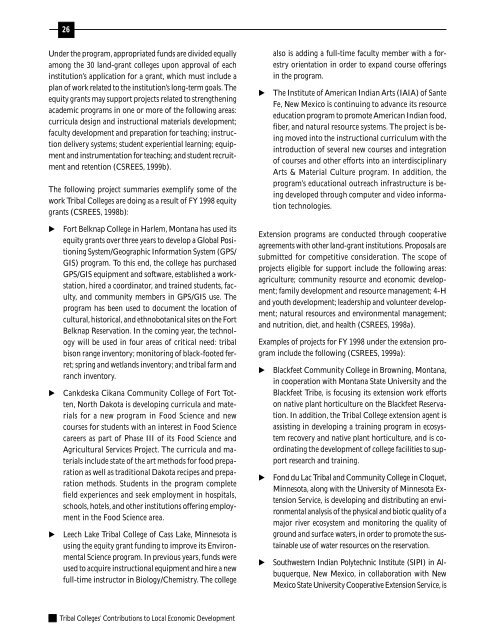Tribal College Contributions to Local Economic Development
Tribal College Contributions to Local Economic Development
Tribal College Contributions to Local Economic Development
- No tags were found...
You also want an ePaper? Increase the reach of your titles
YUMPU automatically turns print PDFs into web optimized ePapers that Google loves.
26Under the program, appropriated funds are divided equallyamong the 30 land-grant colleges upon approval of eachinstitution’s application for a grant, which must include aplan of work related <strong>to</strong> the institution’s long-term goals. Theequity grants may support projects related <strong>to</strong> strengtheningacademic programs in one or more of the following areas:curricula design and instructional materials development;faculty development and preparation for teaching; instructiondelivery systems; student experiential learning; equipmentand instrumentation for teaching; and student recruitmentand retention (CSREES, 1999b).The following project summaries exemplify some of thework <strong>Tribal</strong> <strong>College</strong>s are doing as a result of FY 1998 equitygrants (CSREES, 1998b):also is adding a full-time faculty member with a forestryorientation in order <strong>to</strong> expand course offeringsin the program.The Institute of American Indian Arts (IAIA) of SanteFe, New Mexico is continuing <strong>to</strong> advance its resourceeducation program <strong>to</strong> promote American Indian food,fiber, and natural resource systems. The project is beingmoved in<strong>to</strong> the instructional curriculum with theintroduction of several new courses and integrationof courses and other efforts in<strong>to</strong> an interdisciplinaryArts & Material Culture program. In addition, theprogram’s educational outreach infrastructure is beingdeveloped through computer and video informationtechnologies.Fort Belknap <strong>College</strong> in Harlem, Montana has used itsequity grants over three years <strong>to</strong> develop a Global PositioningSystem/Geographic Information System (GPS/GIS) program. To this end, the college has purchasedGPS/GIS equipment and software, established a workstation,hired a coordina<strong>to</strong>r, and trained students, faculty,and community members in GPS/GIS use. Theprogram has been used <strong>to</strong> document the location ofcultural, his<strong>to</strong>rical, and ethnobotanical sites on the FortBelknap Reservation. In the coming year, the technologywill be used in four areas of critical need: tribalbison range inven<strong>to</strong>ry; moni<strong>to</strong>ring of black-footed ferret;spring and wetlands inven<strong>to</strong>ry; and tribal farm andranch inven<strong>to</strong>ry.Cankdeska Cikana Community <strong>College</strong> of Fort Totten,North Dakota is developing curricula and materialsfor a new program in Food Science and newcourses for students with an interest in Food Sciencecareers as part of Phase III of its Food Science andAgricultural Services Project. The curricula and materialsinclude state of the art methods for food preparationas well as traditional Dakota recipes and preparationmethods. Students in the program completefield experiences and seek employment in hospitals,schools, hotels, and other institutions offering employmentin the Food Science area.Leech Lake <strong>Tribal</strong> <strong>College</strong> of Cass Lake, Minnesota isusing the equity grant funding <strong>to</strong> improve its EnvironmentalScience program. In previous years, funds wereused <strong>to</strong> acquire instructional equipment and hire a newfull-time instruc<strong>to</strong>r in Biology/Chemistry. The collegeExtension programs are conducted through cooperativeagreements with other land-grant institutions. Proposals aresubmitted for competitive consideration. The scope ofprojects eligible for support include the following areas:agriculture; community resource and economic development;family development and resource management; 4-Hand youth development; leadership and volunteer development;natural resources and environmental management;and nutrition, diet, and health (CSREES, 1998a).Examples of projects for FY 1998 under the extension programinclude the following (CSREES, 1999a):Blackfeet Community <strong>College</strong> in Browning, Montana,in cooperation with Montana State University and theBlackfeet Tribe, is focusing its extension work effortson native plant horticulture on the Blackfeet Reservation.In addition, the <strong>Tribal</strong> <strong>College</strong> extension agent isassisting in developing a training program in ecosystemrecovery and native plant horticulture, and is coordinatingthe development of college facilities <strong>to</strong> supportresearch and training.Fond du Lac <strong>Tribal</strong> and Community <strong>College</strong> in Cloquet,Minnesota, along with the University of Minnesota ExtensionService, is developing and distributing an environmentalanalysis of the physical and biotic quality of amajor river ecosystem and moni<strong>to</strong>ring the quality ofground and surface waters, in order <strong>to</strong> promote the sustainableuse of water resources on the reservation.Southwestern Indian Polytechnic Institute (SIPI) in Albuquerque,New Mexico, in collaboration with NewMexico State University Cooperative Extension Service, is<strong>Tribal</strong> <strong>College</strong>s’ <strong>Contributions</strong> <strong>to</strong> <strong>Local</strong> <strong>Economic</strong> <strong>Development</strong>
















